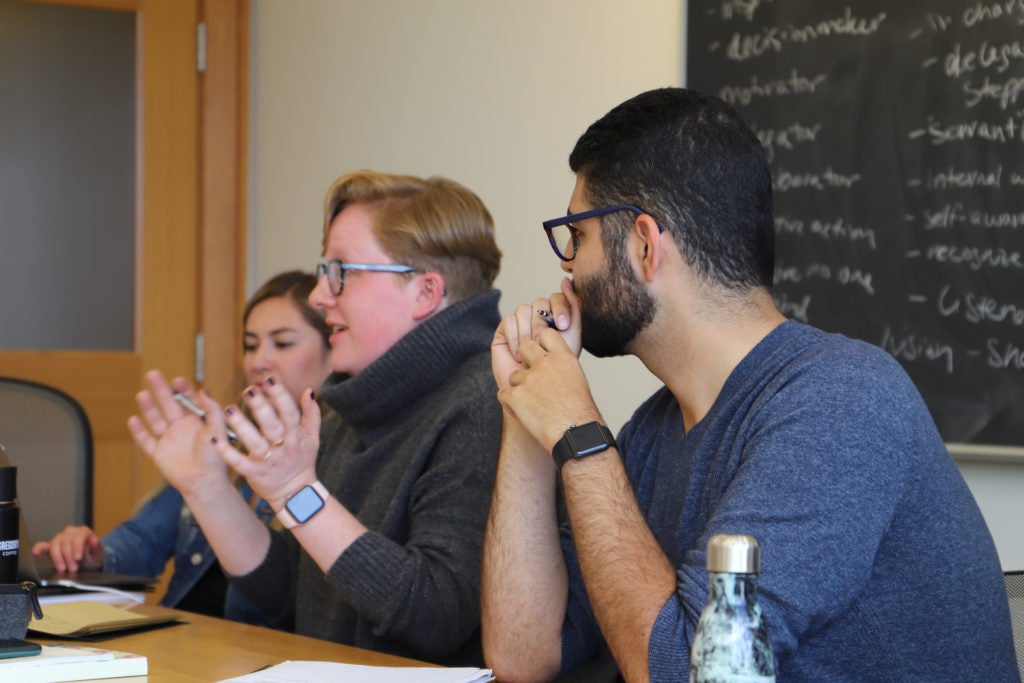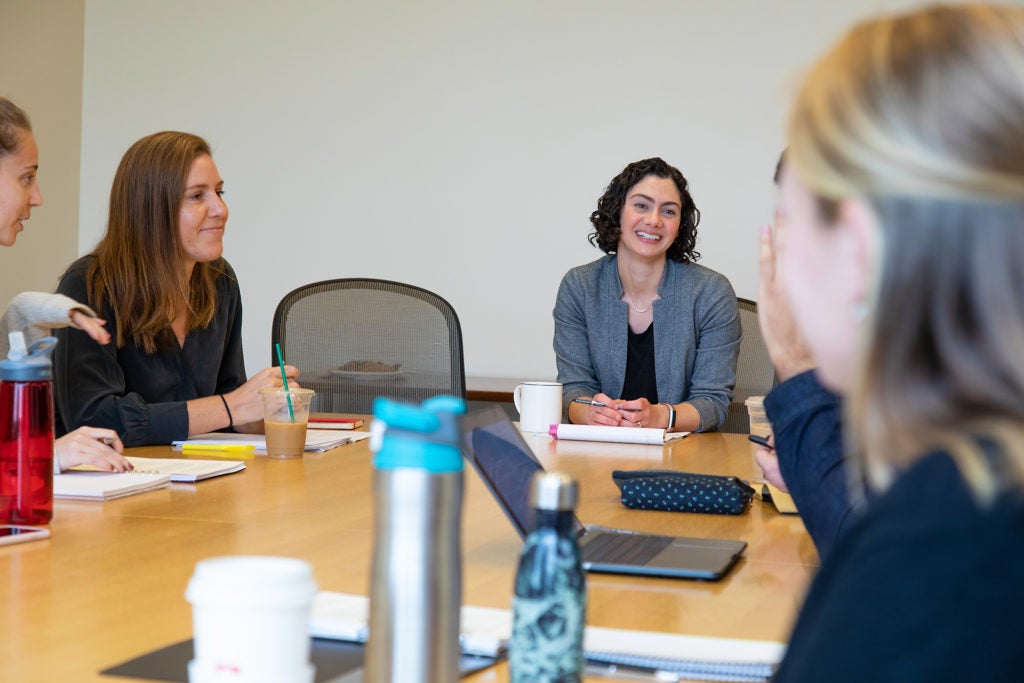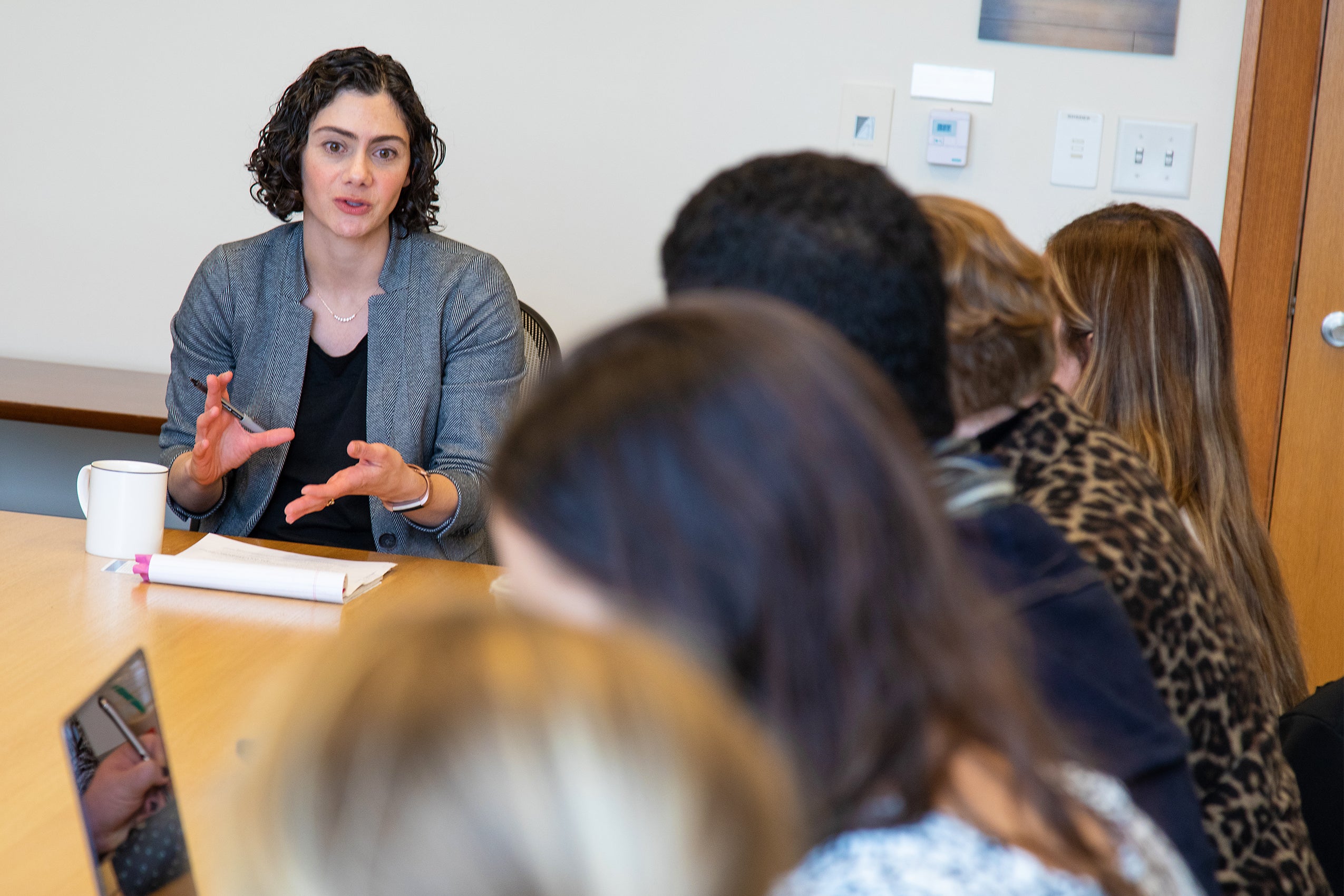Susan Farbstein ’04, clinical professor of law and co-director of the International Human Rights Clinic (IHRC), stands with chalk in hand under a blackboard bearing the word “inspirational.” For the third session of “Human Rights Careers: Strategic Leadership Workshop,” Farbstein has kicked off the discussion by asking students to identify qualities of effective leaders. Adjectives like “empathetic” and “selfless” are enthusiastically shouted across the room.
Throughout the conversation, students are outspoken about considering words like “nurturing”—often traditionally associated with women—along with words like “assertive” and “decisive”—characteristics traditionally coded as masculine, according to “What Makes a Leader?”, an article assigned for class that day. With Farbstein at the helm, the seminar aims to accomplish two goals: to explore the strategic considerations critical to protecting and promoting human rights across the globe, and to investigate the barriers that women face in professional settings, especially in the human rights field.
“The further along I’ve advanced in my profession, the more I’ve become aware of the ways that one’s identity can be both a huge benefit and a huge obstacle,” Farbstein said. Over a 15-year career, she has practiced and taught in the areas of transitional justice, accountability litigation, community lawyering, and economic, social, and cultural rights. Now after working her way into a leadership position at Harvard Law School, she is “trying to make a small intervention for a necessary discussion,” she says. “I want to create space for a conversation that I wish had been taking place more often when I was in law school.”
Alongside Salomé Gómez Upegui LL.M. ’18 and current S.J.D. student Regina Larrea Maccise, Farbstein curated materials on women’s leadership and considered how this topic might be integrated into existing elements of an International Human Rights Clinic seminar, “Advanced Skills Training for Human Rights Advocacy.” Farbstein previously co-taught the class with Tyler Giannini, Human Rights Program and clinic co-director and clinical professor of law. Scenarios and readings in the seminar enable students to target entrenched, structural challenges—inequality, corporate power, climate change—as they prepare to enter the workplace after graduation. The seminar has changed frequently over the years, with students’ interests informing the direction of the class. Throughout, Farbstein and Giannini have always asked students to consider leadership and its interaction with identity.
Over the last year, however, Farbstein realized that she wanted to focus more deeply on the issue of women’s leadership. “It’s so clear from a variety of recent events and public conversations—around unconscious bias, the #MeToo movement, the Kavanaugh hearings, the electability of a woman as president—that we’re struggling with how to achieve true gender parity in our society, including in the workplace,” said Farbstein. “I wanted to do something to respond to this particular moment by bringing those conversations very thoughtfully and intentionally into the classroom and into a field—human rights—where my students aspire to build their careers.”

For the third session of “Human Rights Careers: Strategic Leadership Workshop,” Farbstein kicked off the discussion by asking students to identify qualities of effective leaders.
Farbstein worked with Gómez Upegui and Larrea Maccise to develop four new sessions for the advanced seminar. An introductory session frames the idea of women’s leadership using an intersectional lens, while later classes dissect themes like workplace culture, bias and stereotypes, harassment, and microaggressions within institutional and human rights contexts.
In the first of these four new sessions, Farbstein assigned readings that address the grim statistics around harassment, diversity, and bias. McKinsey’s 2018 Women in the Workplace review, for instance, describes how microaggressions impact a woman’s ability to function in the workplace, with 40 percent of black women surveyed indicating that colleagues routinely question their judgment in their areas of expertise. A Forbes piece on the widespread gender bias faced by female lawyers notes that male law firm partners earn 44 percent more than female partners and that women are more likely to be interrupted when speaking, including at the Supreme Court, where nearly 66 percent of all interruptions are directed at the three female justices.
“To be a working woman is always an act of rebellion,” said Fabiola Alvelais ’20 in response, reflecting on the ways the system simply fails to support professional women.
Beyond exposing the sheer scale of the problem, the statistics serve an additional purpose: They allow Farbstein to engage with her class’s needs and approach the material flexibly, depending on students’ comfort levels. “If they need to stay at a general and abstract level, the numbers are there for them to discuss and reflect on. And if they are comfortable going deeper, which they have been, it gives students who have experienced or encountered gender discrimination in some form the feeling that they’re not the only one out there,” Farbstein said. The statistics hold personal stories within them.
Farbstein’s classroom has a casual intimacy. In part, this is a result of the relaxed tone that she sets and the deep bonds that she develops with her students. The International Human Rights Clinic itself has a community-oriented spirit, and students in the advanced seminar have all spent at least one, and often several, prior semesters together, working on clinical teams or in introductory advocacy seminars.

Students in “Human Rights Careers” describe Farbstein as a professor who fosters an inclusive and comfortable environment. From left: Fabiola Alvelais ’20, Jillian Rafferty ’20 and Daniel Moubayed ’20.
Student Monica Sharma ’20 echoed many of the same words her classmates used to define good leadership when asked to describe Farbstein, in particular noting the way she actively listens to students and lets discussions evolve naturally. Sharma described the advanced seminar as unique, a place where one can formally “consider your power as a Harvard student or as a lawyer.” The discussion, while academic, is inclusive and comfortable, allowing students to draw on their own experiences as well as the readings.
“When you’re talking about ethics or morality, personal narrative comes into play,” Sharma said. “We like to dissociate the law from human experience in a lot of ways, but this class helps you to confront both as they exist in reality and in your work.”
Early in the semester, student Daniel Moubayed ’20 had already found it personally enriching to be brought into the conversation on women’s leadership. “Too often those conversations happen in informal environments. It’s critical that we’re doing this inside the classroom and in a professional setting with a cross section of students,” he said.
In her own teaching, Farbstein seamlessly integrates legal expertise with lived experience. She recognizes that students are not blank slates: they have histories and subjective perspectives that contribute to the debate.
“Part of being a good human rights practitioner is sometimes being vulnerable, drawing on your own life experiences without prejudging the experiences of others, and engaging with the emotions that people carry with them,” Farbstein said. She added, “It’s good practice for students to consider: what is your comfort level when you start to enter this kind of territory?”
For Gómez Upegui, the work she did with Farbstein demonstrated how endemic and culturally rooted the difficulties are, creating situations in which women are dispersed across organizations, lack support networks, and are isolated as they attempt to confront significant challenges.
Still, the breadth of research did not adequately address the marginalization Gómez Upegui, who is Colombian, has witnessed in the legal and human rights fields. “There’s a tremendous lack of intersectional content out there,” she said. “We found endless amounts of work in the business sector and much in the corporate law sector within a white feminist context. Once we narrowed to look at the human rights and social justice fields, the literature winnowed. And we had to fight to find research addressing the lives of women of color or women of low socioeconomic status.”

“These students are each going to be leaders in their own way, and I can already see our conversations informing their decisions and actions,” said Farbstein (center). “Hopefully they will be inspired, and also better equipped, to create more opportunities for women leaders in human rights, and in the legal profession more broadly.”
In addition to the seminar, Farbstein is leading a project in the clinic that investigates gender equity in the human rights field. The team aims to unpack the barriers women human rights advocates face in their professional advancement. Over the course of the year, they will interview a variety of practitioners to provide qualitative evidence to support their findings.
Sharma, who is also a member of Farbstein’s project team, said that engaging with the movement on a self-referential level was vital. She noted that the way lawyers jump to find remedies can often lead to institutional and systemic problems.
Reflecting on the larger importance of the clinical project, Sharma said, “Sometimes in human rights, there is an idea that you sacrifice yourself to the work. Things get lost in the drive to fulfill the mission. It’s important to take a good look and ask, ‘Do organizations practice as they preach?’ I really believe that if you make an atmosphere supportive and encourage diversity of thought, then the work itself will be better.”
The clinical team has already identified factors that may impede gender equity in the human rights field—from the tightly-knit network of practitioners and organizations, to the notion that this is already a progressive space, to a mission-driven “martyr” culture that fosters a sense of selfless dedication to the cause. These initial ideas have, in turn, found their way into the classroom as students consider such obstacles as well as potential strategies to overcome them.
Farbstein hopes that her seminar will help students imagine the kinds of leaders they want to become. “Human rights practitioners talk a lot about how to make the movement more effective and inclusive, but this class is a very concrete step in the right direction,” she said. “These students are each going to be leaders in their own way, and I can already see our conversations informing their decisions and actions. Hopefully they will be inspired, and also better equipped, to create more opportunities for women leaders in human rights, and in the legal profession more broadly.”
